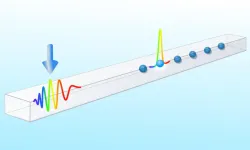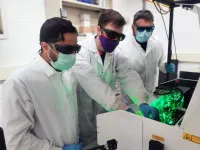(Press-News.org) When people think of sea level rise, they usually think of coastal erosion. However, recent computer modeling studies indicate that coastal wastewater infrastructure, which includes sewer lines and cesspools, is likely to flood with groundwater as sea-level rises.
A new study, published by University of Hawai'i (UH) at Mānoa earth scientists, is the first to provide direct evidence that tidally-driven groundwater inundation of wastewater infrastructure is occurring today in urban Honolulu, Hawai'i. The study shows that higher ocean water levels are leading to wastewater entering storm drains and the coastal ocean--creating negative impacts to coastal water quality and ecological health.
The study was led by postdoctoral researcher Trista McKenzie and co-authored by UH Sea Grant coastal geologist Shellie Habel and Henrietta Dulai, advisor and associate professor in the UH Mānoa School of Ocean and Earth Science and Technology (SOEST). The team assessed coastal ocean water and storm drain water in low-lying areas during spring tides, which serve as an approximation of future sea levels.
To understand the connection between wastewater infrastructure, groundwater and the coastal ocean, the researchers used chemical tracers to detect groundwater discharge and wastewater present at each site. Radon is a naturally occurring gas that reliably indicates the presence of groundwater, while wastewater can be detected by measuring specific organic contaminants from human sources, such as caffeine and certain antibiotics.
"Our results confirm that indeed, both groundwater inundation and wastewater discharge to the coast and storm drains are occurring today and that it is tidally-influenced," said McKenzie. "While the results were predicted, I was surprised how prevalent the evidence for these processes and the scale of it."
In low-lying inland areas, storm drains can overflow every spring tide. This study demonstrated that at the same time wastewater from compromised infrastructure also discharges into storm drains. During high tides, storm drains are becoming channels for untreated wastewater to flood streets and sidewalks. In addition to impeding traffic, including access by emergency vehicles, this flooding of contaminated water also poses a risk to human health.
The team also found evidence that many of the human-derived contaminants were in concentrations that pose a high risk to aquatic organisms. This has negative consequences to coastal organisms where the groundwater and storm drains discharge.
"Many people may think of sea-level rise as a future problem, but in fact, we are already seeing the effects today," said McKenzie. "Further, these threats to human health, ocean ecosystems and the wastewater infrastructure are expected to occur with even greater frequency and magnitude in the future."
This project demonstrates that actions to mitigate the impact from sea-level rise to coastal wastewater infrastructure in Honolulu are no longer proactive but are instead critical to addressing current issues. Through its multi-partner effort, the Hawai'i State Climate Commission also raises awareness around the variety of impacts of sea level rise, including those highlighted by this study.
"Coastal municipalities should pursue mitigation strategies that account for increased connectivity between wastewater infrastructure and recreational and drinking water resources," said McKenzie. "We need to consider infrastructure that minimizes flooding opportunities and contact with contaminated water; and decreases the number of contaminant sources, such as installation of one-way valves for storm drains, decommissioning cesspools, monitoring defective sewer lines, and construction of raised walkways and streets."
INFORMATION:
This study led to McKenzie being awarded the L&O Letters Early Career Publication Honor, given in recognition of the high quality of research conducted by excellent early career scientists.
Light-emitting diodes (LEDs) have revolutionized the displays industry. LEDs use electric current to produce visible light without the excess heat found in traditional light bulbs, a glow called electroluminescence. This breakthrough led to the eye-popping, high-definition viewing experience we've come to expect from our screens. Now, a group of physicists and chemists have developed a new type of LED that utilizes spintronics without needing a magnetic field, magnetic materials or cryogenic temperatures; a "quantum leap" that could take displays to the next level.
"The companies that make LEDs or TV and computer displays don't want to deal with magnetic fields and magnetic materials. It's heavy ...
TOKYO - Toshiba Corporation (TOKYO: 6502), the industry leader in solutions for large-scale optimization problems, today announced a scale-out technology that minimizes hardware limitations, an evolution of its optimization computer, the Simulation Bifurcation Machine (SBM), that supports continued increases in computing speed and scale. Toshiba expects the new SBM to be a game changer for real-world problems that require large-scale, high-speed and low-latency, such as simultaneous financial transactions involving large numbers of stock, and complex control of multiple robots. The research results were published in Nature Electronics*1 on March 1.
Speed and scale are keys to success in industrial sectors ...
Waste cooking oil, sulfur and wool offcuts have been put to good use by green chemists at Flinders University to produce a sustainable new kind of housing insulation material.
The latest environmentally friendly building product from experts at the Flinders Chalker Lab and colleagues at Deakin and Liverpool University, has been described in a new paper published in Chemistry Europe ahead of Global Recycling Day (18 March 2021)
The insulating composite was made from the sustainable building blocks of wool fires, sulfur, and canola oil to produce a promising new model for next-generation insulation - not only capitalising on wool's natural low flammability but also to make significant energy savings for property owners and tenants.
The new composite is one of several exciting ...
Magnetic reconnection refers to the reconfiguration of magnetic field geometry. It plays an elemental role in the rapid release of magnetic energy and its conversion to other forms of energy in magnetized plasma systems throughout the universe.
Researchers led by Dr. LI Leping from the National Astronomical Observatories of the Chinese Academy of Sciences (NAOC) analyzed the evolution of magnetic reconnection and its nearby filament. The result suggested that reconnection is significantly accelerated by the propagating disturbance caused by the adjacent filament eruption.
The study was published in The Astrophysical Journal on Feb. 25.
The New Vacuum Solar Telescope (NVST) is a ...
In order to exploit the properties of quantum physics technologically, quantum objects and their interaction must be precisely controlled. In many cases, this is done using light. Researchers at the University of Innsbruck and the Institute of Quantum Optics and Quantum Information (IQOQI) of the Austrian Academy of Sciences have now developed a method to individually address quantum emitters using tailored light pulses. "Not only is it important to individually control and read the state of the emitters," says Oriol Romero-Isart, "but also to do so while leaving the system as undisturbed as possible." Together with Juan Jose? Garci?a-Ripoll (IQOQI visiting fellow) from the Instituto de Fi?sica Fundamental in Madrid, Romero-Isart's research group has ...
CLEMSON, South Carolina -- By using laser spectroscopy in a photophysics experiment, Clemson University researchers have broken new ground that could result in faster and cheaper energy to power electronics.
This novel approach, using solution-processed perovskite, is intended to revolutionize a variety of everyday objects such as solar cells, LEDs, photodetectors for smart phones and computer chips. Solution-processed perovskite are the next generation materials for solar cell panels on rooftops, X-ray detectors for medical diagnosis, and LEDs for daily-life lighting.
The research team included ...
A multiyear workplace health promotion program can slow down the increase in health risks for working-age people. A study by the Faculty of Sport and Health Sciences at the University of Jyväskylä followed what kind of changes happened among participants during an eight-year workplace health promotion program in smoking, minor exercise, high blood pressure, musculoskeletal disorders, and overweight. The results of the study were encouraging for health promotion.
According to earlier studies, a high number of health risks are connected to an increase in occupational health care costs, lower productivity at work, and the growing number of sickness ...
CLEVELAND--Scientists at the Case Western Reserve University School of Medicine have determined the structure of protein "fibrils" linked to Lou Gehrig's disease and other neurodegenerative disorders--findings that provide clues to how toxic proteins clump and spread between nerve cells in the brain.
Their results may also lead to developing drugs to treat diseases such as amyotrophic lateral sclerosis (ALS) and frontotemporal dementia (FTD).
"These devastating brain disorders that affect tens of thousands of Americans?are on the rise worldwide, and there are no effective treatments to ...
Researchers at Tufts University School of Engineering have created light-activated composite devices able to execute precise, visible movements and form complex three-dimensional shapes without the need for wires or other actuating materials or energy sources. The design combines programmable photonic crystals with an elastomeric composite that can be engineered at the macro and nano scale to respond to illumination.
The research provides new avenues for the development of smart light-driven systems such as high-efficiency, self-aligning solar cells that automatically follow the sun's direction and angle of light, light-actuated microfluidic valves or soft robots that move with light on demand. A "photonic sunflower," whose petals curl ...
A new study led by University of Maryland and UCLA researchers found that DNA from tissue samples can be used to accurately predict the age of bats in the wild. The study also showed age-related changes to the DNA of long-lived species are different from those in short-lived species, especially in regions of the genome near genes associated with cancer and immunity. This work provides new insight into causes of age-related declines.
This is the first research paper to show that animals in the wild can be accurately aged using an epigenetic clock, which predicts age based on specific changes to DNA. This work ...








